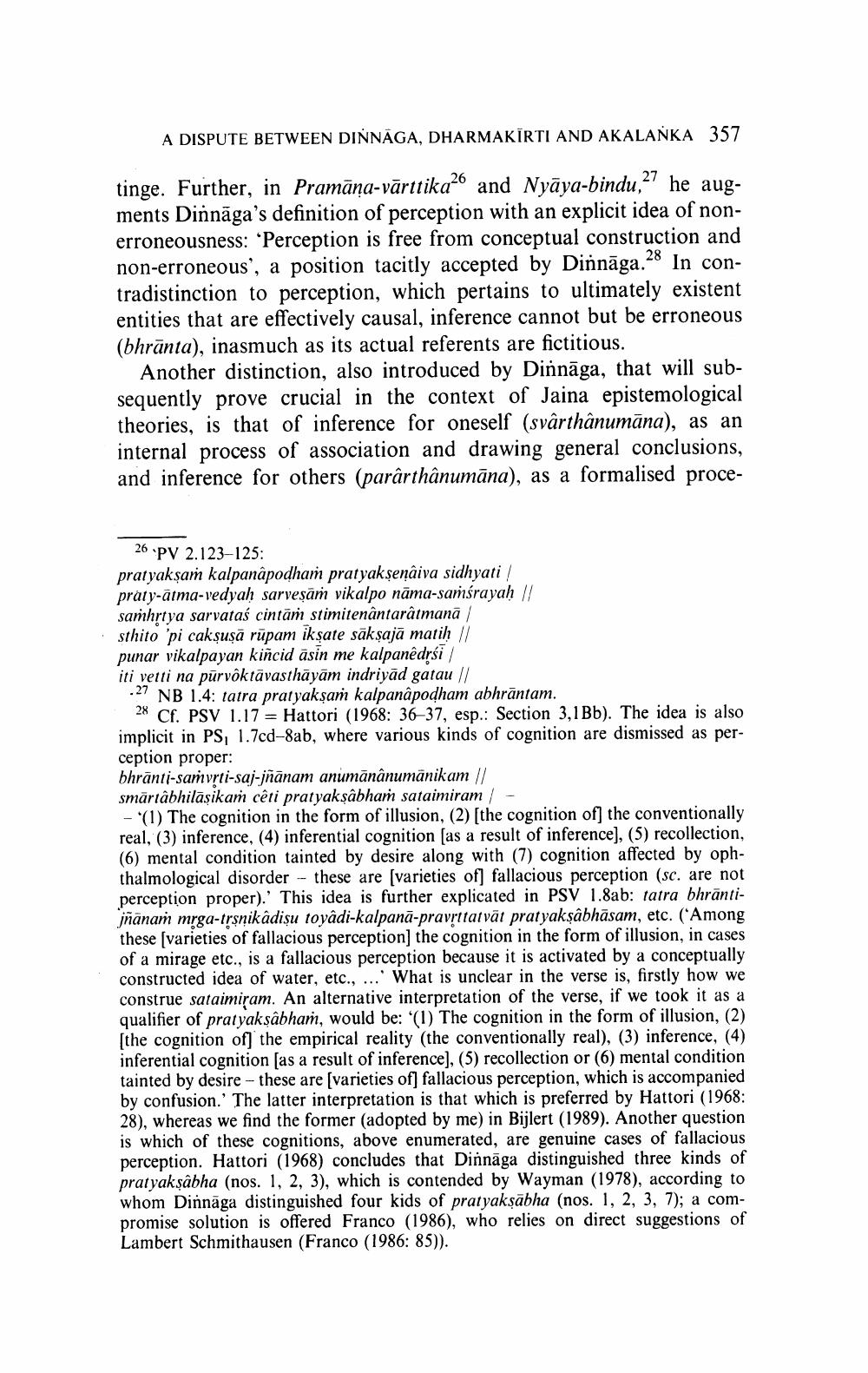________________
A DISPUTE BETWEEN DINNAGA, DHARMAKIRTI AND AKALANKA 357
tinge. Further, in Pramāṇa-vārttika26 and Nyāya-bindu,27 he augments Dinnaga's definition of perception with an explicit idea of nonerroneousness: 'Perception is free from conceptual construction and non-erroneous', a position tacitly accepted by Dinnaga.28 In contradistinction to perception, which pertains to ultimately existent entities that are effectively causal, inference cannot but be erroneous (bhrānta), inasmuch as its actual referents are fictitious.
Another distinction, also introduced by Dinnaga, that will subsequently prove crucial in the context of Jaina epistemological theories, is that of inference for oneself (svârthânumāna), as an internal process of association and drawing general conclusions, and inference for others (parârthânumāna), as a formalised proce
26 PV 2.123-125:
pratyakṣam kalpanapodham pratyakşenâiva sidhyati | praty-atma-vedyah sarveṣām vikalpo nama-samśrayaḥ || samhrtya sarvatas cintam stimitenântarâtmanā | sthito 'pi cakṣuṣā rūpam ikṣate säkṣajā matih || punar vikalpayan kiñcid äsin me kalpanêdrsi iti vetti na pūrvôktavasthāyām indriyad gatau ||
27 NB 1.4: tatra pratyakṣam kalpanapodham abhrāntam.
28 Cf. PSV 1.17 Hattori (1968: 36-37, esp.: Section 3,1 Bb). The idea is also implicit in PS, 1.7cd-8ab, where various kinds of cognition are dismissed as perception proper:
bhrānti-samvṛti-saj-jñānam anumänânumānikam || smartâbhilaṣikam cêti pratyakṣâbham sataimiram |
- (1) The cognition in the form of illusion, (2) [the cognition of] the conventionally real, (3) inference, (4) inferential cognition [as a result of inference], (5) recollection, (6) mental condition tainted by desire along with (7) cognition affected by ophthalmological disorder - these are [varieties of] fallacious perception (sc. are not perception proper).' This idea is further explicated in PSV 1.8ab: tatra bhrāntijnanam mrga-trsnikâdiṣu toyâdi-kalpana-pravṛttatvät pratyakṣâbhāsam, etc. ('Among these [varieties of fallacious perception] the cognition in the form of illusion, in cases of a mirage etc., is a fallacious perception because it is activated by a conceptually constructed idea of water, etc., ... What is unclear in the verse is, firstly how we construe sataimiram. An alternative interpretation of the verse, if we took it as a qualifier of pratyakṣabham, would be: (1) The cognition in the form of illusion, (2) [the cognition of] the empirical reality (the conventionally real), (3) inference, (4) inferential cognition [as a result of inference], (5) recollection or (6) mental condition tainted by desire - these are [varieties of] fallacious perception, which is accompanied by confusion.' The latter interpretation is that which is preferred by Hattori (1968: 28), whereas we find the former (adopted by me) in Bijlert (1989). Another question is which of these cognitions, above enumerated, are genuine cases of fallacious perception. Hattori (1968) concludes that Dinnaga distinguished three kinds of pratyakṣabha (nos. 1, 2, 3), which is contended by Wayman (1978), according to whom Dinnaga distinguished four kids of pratyakṣābha (nos. 1, 2, 3, 7); a compromise solution is offered Franco (1986), who relies on direct suggestions of Lambert Schmithausen (Franco (1986: 85)).




